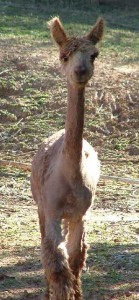Shearing Alpacas
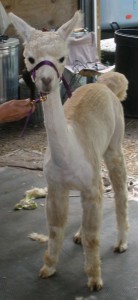 One of the most important things we do to care for our alpacas each year is to shear them. Our alpacas grow fiber between 2-6 inches long all over their bodies each year, which can total 3-11 pounds per alpaca. When the hot weather arrives, this beautiful, warm fiber can become incredibly hot for any alpaca not shorn, and can lead to heat stress and even death if it is not removed.
One of the most important things we do to care for our alpacas each year is to shear them. Our alpacas grow fiber between 2-6 inches long all over their bodies each year, which can total 3-11 pounds per alpaca. When the hot weather arrives, this beautiful, warm fiber can become incredibly hot for any alpaca not shorn, and can lead to heat stress and even death if it is not removed.
We shear our alpacas each year near the first of May. Our goal is to shear before it gets too hot, but late enough in the year the alpacas won’t get too cold without their coats.
 The shearing process takes about 15-30 minutes per alpaca. We restrain the alpacas so they do not move while we are shearing. The shears we use (the same used for sheep) are very safe, but could nick the alpacas if they move around during the shearing process.
The shearing process takes about 15-30 minutes per alpaca. We restrain the alpacas so they do not move while we are shearing. The shears we use (the same used for sheep) are very safe, but could nick the alpacas if they move around during the shearing process.
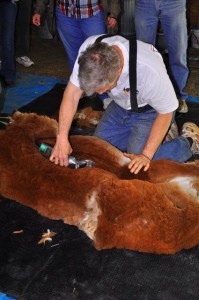 On shearing day, we gather the alpacas close to the barn. They are led into the shearing area on a halter and laid down on the shearing mat. We use the Pro-Tie system to hold their legs so they hold still during shearing, and someone always holds their head and talks with them as we shear. One side is shorn, following a very specific pattern to keep separate the coarser belly and leg fibers (thirds) from the blanket fiber (first or prime fiber) and neck fiber (seconds). The blanket fiber rolls off the alpaca as it is cut and can be pulled off in one or two pieces, depending on one’s shearing style. We shear one half, then turn the alpaca and shear the other side. Often toenails and teeth are trimmed at this time if necessary and annual shots for tetanus and rabies given.
On shearing day, we gather the alpacas close to the barn. They are led into the shearing area on a halter and laid down on the shearing mat. We use the Pro-Tie system to hold their legs so they hold still during shearing, and someone always holds their head and talks with them as we shear. One side is shorn, following a very specific pattern to keep separate the coarser belly and leg fibers (thirds) from the blanket fiber (first or prime fiber) and neck fiber (seconds). The blanket fiber rolls off the alpaca as it is cut and can be pulled off in one or two pieces, depending on one’s shearing style. We shear one half, then turn the alpaca and shear the other side. Often toenails and teeth are trimmed at this time if necessary and annual shots for tetanus and rabies given.
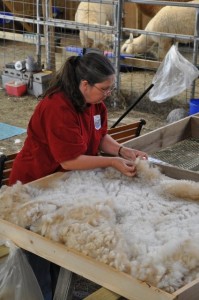 As the fiber comes off the alpaca, each of the three grades of fiber are placed on a separate sorting tray with a hardware cloth bottom. This open wire bottom allows dirt and debris to fall through, while the fiber is quickly sorted to pull out large pieces of hay and other pasture debris and sort out any hairy or short pieces of fiber called second cuts, which are caused if the shears take a second pass through an already shorn area. If left in with the longer fiber, these second cuts can cause slubs in the yarn when processed, leaving it lumpy and more likely to shed these short fibers over time. Often, there is not enough time to carefully sort the blanket fiber during the shearing day, so we roll it in a large piece of kraft paper to keep the shape intact and store it for later sorting. This is the fiber that the best yarn is made of, as well as the fiber that will be prepared for fleece shows and spinoffs, so it is important to handle the blanket with care. You can learn more about the sorting and yarn making process from an earlier post.
As the fiber comes off the alpaca, each of the three grades of fiber are placed on a separate sorting tray with a hardware cloth bottom. This open wire bottom allows dirt and debris to fall through, while the fiber is quickly sorted to pull out large pieces of hay and other pasture debris and sort out any hairy or short pieces of fiber called second cuts, which are caused if the shears take a second pass through an already shorn area. If left in with the longer fiber, these second cuts can cause slubs in the yarn when processed, leaving it lumpy and more likely to shed these short fibers over time. Often, there is not enough time to carefully sort the blanket fiber during the shearing day, so we roll it in a large piece of kraft paper to keep the shape intact and store it for later sorting. This is the fiber that the best yarn is made of, as well as the fiber that will be prepared for fleece shows and spinoffs, so it is important to handle the blanket with care. You can learn more about the sorting and yarn making process from an earlier post.
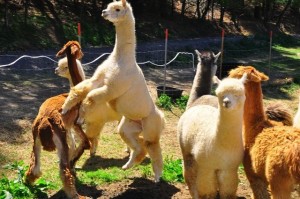 After the alpaca is shorn, we put their halter back on, release them from the mat, and walk them back into the pasture. The boys often will run around the pasture and seem to make fun of the first few shorn, with those who still have their fleeces showing off how much bigger they are. The girls are curious about other girls’ new haircuts, but after a few sniffs, usually go right back to eating. The alpacas themselves seem to be pleased with their new haircuts and the fresh feeling of giving up all that fiber. They are now ready to face the summer warmth and love to roll and sunbathe, leaving us to put last year’s fiber growth to good use, while they start growing next year’s crop.
After the alpaca is shorn, we put their halter back on, release them from the mat, and walk them back into the pasture. The boys often will run around the pasture and seem to make fun of the first few shorn, with those who still have their fleeces showing off how much bigger they are. The girls are curious about other girls’ new haircuts, but after a few sniffs, usually go right back to eating. The alpacas themselves seem to be pleased with their new haircuts and the fresh feeling of giving up all that fiber. They are now ready to face the summer warmth and love to roll and sunbathe, leaving us to put last year’s fiber growth to good use, while they start growing next year’s crop.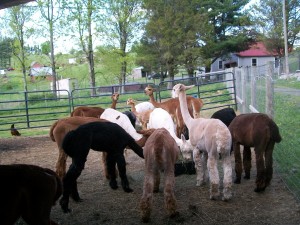
You can see more pictures from previous shearing days here and here.
